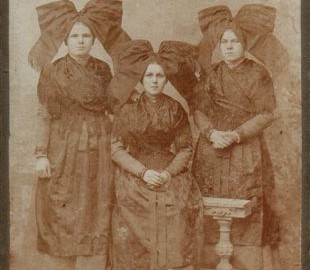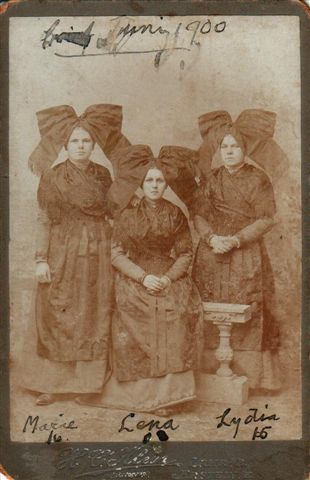My post Who’s in that photo? from September received a comment today from Jane, who had a photo she couldn’t figure out as well. She knew the names of the people in the photo (they were her great-grandfather’s sisters), but didn’t understand the significance of the massive bows on their heads. She asked if it was a fashion thing, or perhaps a religious requirement? Someone suggested to her that it might be a Jewish headdress, and thus she was asking here for advice on the photo.
Here’s the photo, one of the more interesting family photos I’ve seen:
Now first let me say, nothing about the bows looked familiar to me. I’m not an expert on Jewish headdress or historical fashion, but I was pretty sure this was not a specifically Jewish headdress.
So what is its significance? Considering all three sisters are wearing the same headdress, my initial guess was that it would not be simply a fleeting fashion choice, but had to have some cultural or religious significance. How many sisters do you know who otherwise would wear the same outfits?
I can’t say for sure that I know the origin of these bows, but I suspect from the research I did that these are in fact Alsatian headdresses called schlupfkàpp (a ‘bow cap’). In the 19th century the region of Alsace-Lorraine developed a unique form of headdress that lasted into the 1940s before mostly disappearing. Early in the 19th century the bows were relatively small, but apparently the bows grew in size until they peaked in size around the turn of the century, exactly when Jane’s photo was taken.
Here are a few examples of the style:
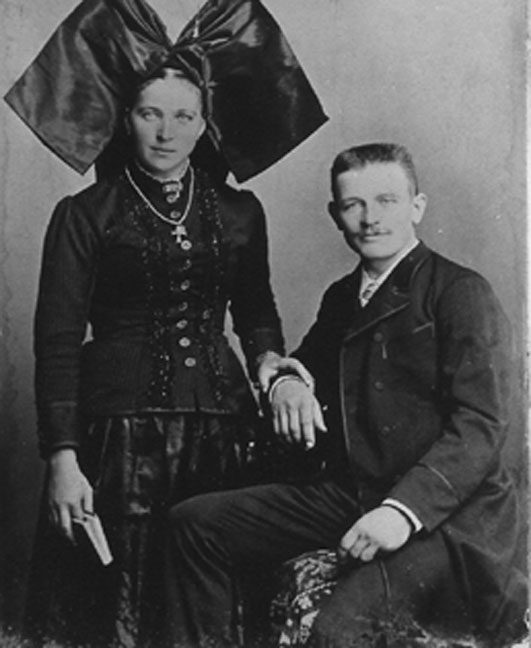 |
| 1919 illustration of traditional Alsatian costumes (Wikimedia Commons) |
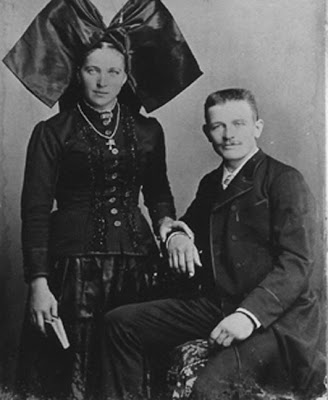 |
| Husband with wife in traditional Alsatian costume, about 1875 (Christ Family) |
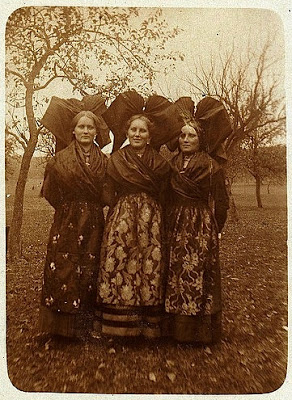 |
| Three sisters in Alsatian folk dress (Flickr) |
Most sources point out that single women wore these bows in specific colors indicating their religion – Protestants wore Black bows, and Catholics wore brightly colored ones, usually Red. Apparently after marriage both Protestants and Catholics would wear black bows. One source I found mentioned that Jews wore Lavender bows, although I haven’t found any other reference for that fact.
I certainly can’t determine the color of the bows in Jane’s photograph since it’s black and white, so even though they seem black to me that might not be the case. I also can’t read the location of the studio where the photograph was taken, although it could have been taken anywhere (although if it is in Alsace-Lorraine that would certainly seem to confirm my guess).
What I would suggest for Jane is to try to contact someone who knows about traditional Alsatian costumes. One other reason to do this, especially if Jane does not know what town her family came from, would be to determine the specific type of headdress her family members were wearing. Apparently the style of the bows varied from village to village, and it might be possible for someone to figure out the region or even the specific town by seeing the style of the bow.
One place to look is the Alsace Tourism web site, which has a section on Alsatian Costume. The web site even has a map showing the origin of specific headdresses in Alsace. The site also links to two different cultural groups and the Alsatian Museum in Strasbourg, all of which might be able to help figure out the specific origin of the bows in Jane’s photo. Another option if Jane doesn’t know where her great-grandfather came from is to track down his origin and seeing if he tracks back to a town in Alsace-Lorraine. If he moved to the US, she can using the techniques I wrote up previously in my article Finding Information on US Immigrants.
Certainly, this is an interesting example of using family photographs to locate the origin of a family. Even if the photo was taken in London or Chicago, it would still point to the family coming from Alsace-Lorraine and may even (with some expert help) point to the specific region or town. Of course, I don’t have a lot of information about the family and could be totally off-base. I’m sure everyone reading this would appreciate if Jane would post in the comments if my guess is right and she confirms the origin of the headdress (and her family) as coming from Alsace-Lorraine.
